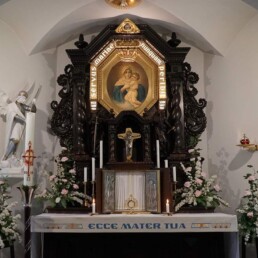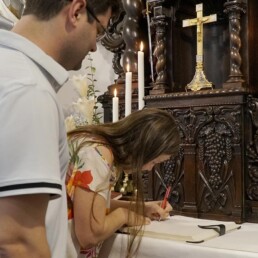The Covenant of Love is an act of consecration (as individual or community) to Mary as the Mother Thrice Admirable of Schoenstatt
Schoenstatt’s founding act in 1914 is the moment when Father Kentenich and the founding generation offered their striving for sanctity and asked Mary to come to dwell in their chapel, the Schoenstatt Shrine, transforming it into a place of pilgrimage and their cradle of sanctity. It is from this original act that Schoenstatt’s life, identity, and fruitfulness flow.

Schoenstatt’s founding act in 1914 is the moment when Father Kentenich and the founding generation offered their striving for sanctity and asked Mary to come to dwell in their chapel, the Schoenstatt Shrine, transforming it into a place of pilgrimage and their cradle of sanctity. It is from this original act that Schoenstatt’s life, identity, and fruitfulness flow.
The covenant of love is an act of consecration (as individual or community) to Mary as the Mother Thrice Admirable of Schoenstatt. It brings about a deeper relationship with Mary and gives one full participation in the stream of life and graces originating in the covenant of 1914 and flowing from the shrine. Each new member or group also contributes in a unique way to the original covenant, enhancing and enriching it, even while the covenant enhances and enriches the life of each member or group in return.
The covenant of love is a recognized form of Marian consecration in the Church. Like the consecration of the Marian Sodality, the De Montfort (Grignion) consecration and other forms of consecrations to Mary, it consists of total giving of oneself to Mary. Father Kentenich characterized Marian consecrations as a total and mutual exchange of hearts, goods, and interests. Through this exchange, one grows in love, in one’s overall spiritual life, and in the ability to fulfill one’s mission. In the Catholic experience, Mary has proven to be an outstanding consecration partner, leading persons, nations, communities, and generations to a deeper fervor of love and commitment to Christ and the Triune God.
Grow in love, in one’s overall spiritual life and in the ability to fulfill one’s mission
“Nothing without you, MTA, nothing without us”
The saying “Nothing without you, nothing without us” is often found on an antependium (a decorative front to the altar cloth) in the shrine.
This tradition goes back to 1933 and is an expression of the covenant of love. The “nothing without you” indicates Schoenstatt’s dependence on the presence and activity of Mary in the shrine. The “nothing without us” indicates the necessity of our cooperation and striving so that the terms by which Mary was persuaded to come to dwell in Schoenstatt are met.

